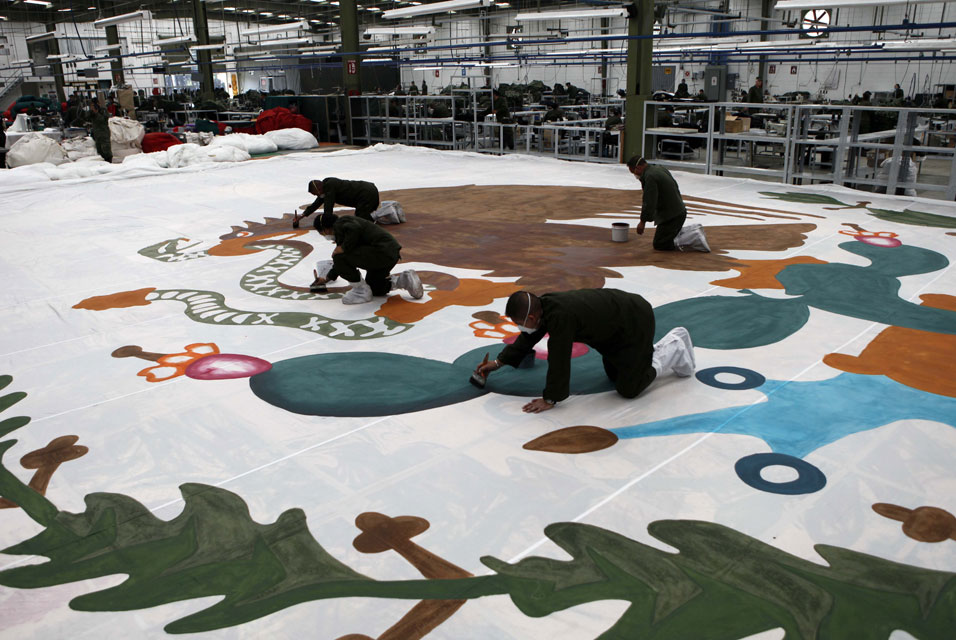
MEXICO CITY.- Soldiers paint the symbols of an oversized Mexican flag in Mexico City, Wednesday Feb. 23 2011. Mexicans celebrate Dia de la Bandera or Flag Day every year on February 24. AP Photo/Eduardo Verdugo.
HANOVER.- In the first institutional solo exhibition in Germany of works by the American photographer David LaChapelle (*1964), the kestnergesellschaft presents a series of new, not yet shown photographs. The series Earth Laughs in Flowers, which was created this year, refers to art-historical visual traditions but never loses sight of LaChapelle’s own artistic language. The large-format still lifes in this series, with titles such as The Lovers, Concerning the Soul, Risk or America, seamlessly take up the principle of exaggeration that characterized the portraits of celebrities like Madonna, Pamela Anderson, Michael Jackson, Björk or David Bowie through which LaChapelle himself has become famous since the 1990s. The portraits always contained art-historical references, along with a fear of emptiness, a love of bad taste, an ugly beauty, but David LaChapelle’s recent works now show an explicit compositional affinity to Baroque floral still lifes. Plants, fruits and objects, in place of human bodies, now bear witness to human pride, to the finiteness of life with its obsessions and compulsions, to pleasure and suffering.
STUTTGART.- For museums the exchange with private collectors is becoming increasingly important. A new series of exhibitions in the Kunstmuseum aims to make the engagement of these art patrons visible. The first show presents Ute and Rudolf Scharpff, who have been collecting for over fifty years and in the 1960s initially concentrated on the Nouveaux Réalistes. Today their collection comprises art by the Zero Group and German and American contemporary painting. Included are works by well-known artists such as Yves Klein, Lucio Fontana, Piero Manzoni, Franz Ackermann, André Butzer, Albert Oehlen, Neo Rauch, Christopher Wool, and Jeff Koons. Ute and Rufolf Scharpff are interested particularly in young artists whose works deal critically with the present. For the exhibition in the Kunstmuseum, the Scharpffs have chosen an exceptional focus on their collecting activity of more than five decades: New York graffiti art of the 1980s. At that time Rudolf Scharpff traveled frequently to New York and encountered a subculture in upheaval. Anti-graffiti campaigns organized by the city forced artists to seek out new media for their writing and pictures. Rudolf Scharpff was thus able to acquire the first work on large-format canvases by graffiti art pioneers such as Phase 2, Mico, Futura 2000, and Rammellzee. What interested the Stuttgart collector couple above all in these works by the graffiti artists was the “immediate form of expression of an almost action painting-like art.” The works shown in the Kunstmuseum offer a lively picture of the New York sprayer scene of the time and reflect issues in American society that are still current today.
LONDON.- Jan Gossaert (active 1503; died 1532) was one of the most startling and versatile artists of the Northern Renaissance. A pivotal Old Master, Gossaert changed the course of Flemish art, going beyond the tradition of Jan van Eyck and charting new territory that eventually led to the great age of Rubens – yet this is the first major exhibition dedicated to him in more than 45 years. 'Jan Gossaert’s Renaissance' includes more than 80 works, and places Gossaert in the context of the art and artists that influenced his development. It brings together many of the artist’s most important paintings ('Virgin and Child', about 1527,Museo Nacional del Prado, Madrid; 'Hercules and Deianeira', 1517, Barber Institute of Fine Arts, Birmingham; and 'Saint Luke Painting the Virgin', 1520–22, Kunsthistorisches Museum, Vienna) with drawings, prints and contemporaneous sculptures.
From http://www.artdaily.com



No comments:
Post a Comment